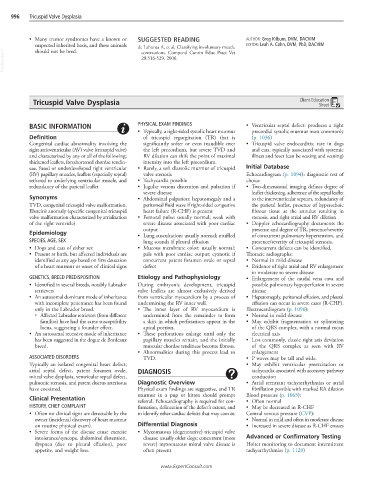Page 1988 - Cote clinical veterinary advisor dogs and cats 4th
P. 1988
996 Tricuspid Valve Dysplasia
• Many tremor syndromes have a known or SUGGESTED READING AUTHOR: Greg Kilburn, DVM, DACVIM
suspected inherited basis, and these animals de Lahunta A, et al: Classifying involuntary muscle EDITOR: Leah A. Cohn, DVM, PhD, DACVIM
should not be bred.
VetBooks.ir contractions. Compend Contin Educ Pract Vet
28:516-529, 2006.
Tricuspid Valve Dysplasia Client Education
Sheet
BASIC INFORMATION PHYSICAL EXAM FINDINGS • Ventricular septal defect: produces a right
• Typically, a right-sided systolic heart murmur precordial systolic murmur most commonly
Definition of tricuspid regurgitation (TR) that is (p. 1036)
Congenital cardiac abnormality involving the significantly softer or even inaudible over • Tricuspid valve endocarditis: rare in dogs
right atrioventricular (AV) valve (tricuspid valve) the left precordium, but severe TVD and and cats, typically associated with systemic
and characterized by any or all of the following: RV dilation can shift the point of maximal illness and fever (can be waxing and waning)
thickened leaflets, foreshortened chordae tendin- intensity into the left precordium.
eae, fused or underdeveloped right ventricular • Rarely, a soft diastolic murmur of tricuspid Initial Database
(RV) papillary muscles, leaflets (especially septal) valve stenosis Echocardiogram (p. 1094): diagnostic test of
tethered to underlying ventricular muscle, and • Tachycardia possible choice
redundancy of the parietal leaflet • Jugular venous distention and pulsation if • Two-dimensional imaging defines degree of
severe disease leaflet thickening, adherence of the septal leaflet
Synonyms • Abdominal palpation: hepatomegaly and a to the interventricular septum, redundancy of
TVD, congenital tricuspid valve malformation, peritoneal fluid wave if right-sided congestive the parietal leaflet, presence of hyperechoic
Ebstein’s anomaly (specific congenital tricuspid heart failure (R-CHF) is present fibrous tissue at the annulus resulting in
valve malformation characterized by atrialization • Femoral pulse: usually normal; weak with stenosis, and right atrial and RV dilation
of the right ventricle) severe disease associated with poor cardiac • Doppler echocardiography documents the
output presence and degree of TR, presence/severity
Epidemiology • Lung auscultation: usually normal; muffled of concurrent pulmonary hypertension, and
SPECIES, AGE, SEX lung sounds if pleural effusion presence/severity of tricuspid stenosis.
• Dogs and cats of either sex • Mucous membrane color: usually normal; • Concurrent defects can be identified.
• Present at birth, but affected individuals are pale with poor cardiac output; cyanotic if Thoracic radiographs:
identified at any age based on first detection concurrent patent foramen ovale or septal • Normal in mild disease
of a heart murmur or onset of clinical signs defect • Evidence of right atrial and RV enlargement
in moderate to severe disease
GENETICS, BREED PREDISPOSITION Etiology and Pathophysiology • Enlargement of the caudal vena cava and
• Identified in several breeds, notably Labrador During embryonic development, tricuspid possible pulmonary hypoperfusion in severe
retrievers valve leaflets are almost exclusively derived disease
• An autosomal dominant mode of inheritance from ventricular myocardium by a process of • Hepatomegaly, peritoneal effusion, and pleural
with incomplete penetrance has been found undermining the RV inner wall. effusion can occur in severe cases (R-CHF).
only in the Labrador breed. • The inner layer of RV myocardium is Electrocardiogram (p. 1096):
○ Affected Labrador retrievers (from different undermined from the remainder to form • Normal in mild disease
families) have had the same susceptibility a skirt in which perforations appear in the • May exhibit fragmentation or splintering
locus, suggesting a founder effect. apical portion. of the QRS complex, with a normal mean
• An autosomal recessive mode of inheritance • These perforations enlarge until only the electrical axis
has been suggested in the dogue de Bordeaux papillary muscles remain, and the initially • Less commonly, classic right axis deviation
breed. muscular chordae tendineae become fibrous. of the QRS complex as seen with RV
• Abnormalities during this process lead to enlargement
ASSOCIATED DISORDERS TVD. • P waves may be tall and wide.
Typically an isolated congenital heart defect; • May exhibit ventricular preexcitation or
atrial septal defect, patent foramen ovale, DIAGNOSIS tachycardia associated with accessory pathway
mitral valve dysplasia, ventricular septal defect, conduction
pulmonic stenosis, and patent ductus arteriosus Diagnostic Overview • Atrial reentrant tachyarrhythmias or atrial
have coexisted. Physical exam findings are suggestive, and TR fibrillation possible with marked RA dilation
murmur in a pup or kitten should prompt Blood pressure (p. 1065):
Clinical Presentation referral. Echocardiography is required for con- • Often normal
HISTORY, CHIEF COMPLAINT firmation, delineation of the defect’s extent, and • May be decreased in R-CHF
• Often no clinical signs are detectable by the to identify other cardiac defects that may coexist. Central venous pressure (CVP):
owner (incidental discovery of heart murmur • Normal in mild and often in moderate disease
on routine physical exam). Differential Diagnosis • Increased in severe disease as R-CHF ensues
• Severe forms of the disease cause exercise • Myxomatous (degenerative) tricuspid valve
intolerance/syncope, abdominal distention, disease: usually older dogs; concurrent (more Advanced or Confirmatory Testing
dyspnea (due to pleural effusion), poor severe) myxomatous mitral valve disease is Holter monitoring to document intermittent
appetite, and weight loss. often present tachyarrhythmias (p. 1120)
www.ExpertConsult.com

